-
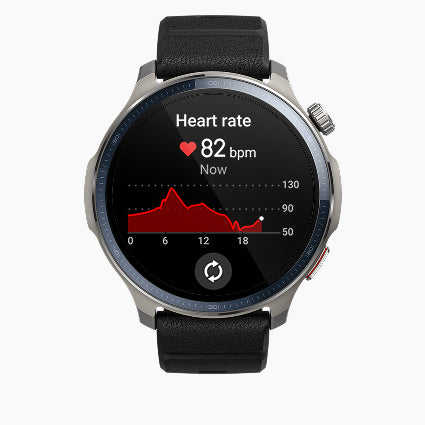
Heart Rate Monitoring
Heart rate (HR), measured in beats per minute (bpm), is one of the most widely used indicators for understanding how your body is responding—whether you're pushing through a workout or recovering after one.
A higher-than-usual HR at rest, or a lower-than-expected HR during downtime, can signal that something's off. That's why Amazfit watches give you real time heart monitoring and customizable alerts, so you can stay in tune with your body and take action when it matters most. -
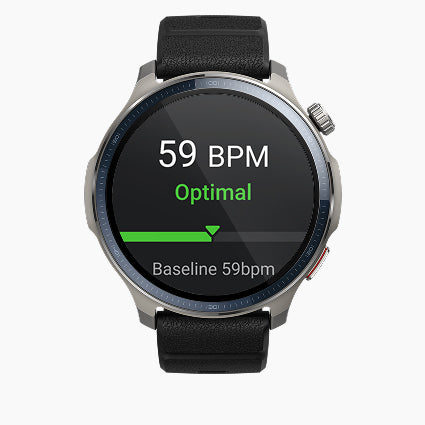
Resting Heart Rate (RHR)
Your sleep Resting Heart Rate (RHR) is the number of times your heart beats per minute while you're asleep. Generally, a lower RHR indicates better overall health, as it suggests your heart is functioning efficiently and your body is well-recovered. A lower RHR can also help your body handle more intense physical activity, such as high intensity exercise.
However, a very low or very high RHR may be a sign of underlying issues such as illness, stress, anxiety, or lifestyle factors like caffeine intake, changes in exercise habits, or irregular sleep patterns. If your RHR is unusually low or high, monitor for symptoms like dizziness, shortness of breath, or fatigue—and be sure to rest when needed. -
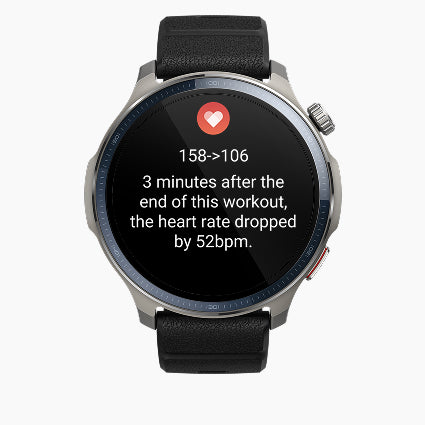
Post-workout Heart Rate (Recovery)
Post-workout heart rate recovery (HRR) is a key fitness indicator that measures how quickly your heart rate drops after exercise. It reflects the efficiency of your cardiovascular system and your body’s ability to return to a resting state after exertion. After you complete a workout, your Amazfit watch tracks how much your heart rate decreases in the first 1 to 2 minutes of rest.
For example:1-minute HRR = Heart rate at end of workout − Heart rate after 1 minute
2-minute HRR = Heart rate at end of workout − Heart rate after 2 minutes
This data is typically displayed on screen or in the Zepp App immediately after your session.A drop of 12 bpm or more after 1 minute is generally a sign of good heart health.
A drop of 22 bpm or more after 2 minutes is even better.
Slower recovery could indicate fatigue, overtraining, or lower fitness levels.
A high HRR means you are well conditioned and your parasympathetic nervous system (responsible for rest and recovery) is responding efficiently. A lower HRR may suggest incomplete recovery, elevated stress, or a need for additional rest before your next intense workout. -
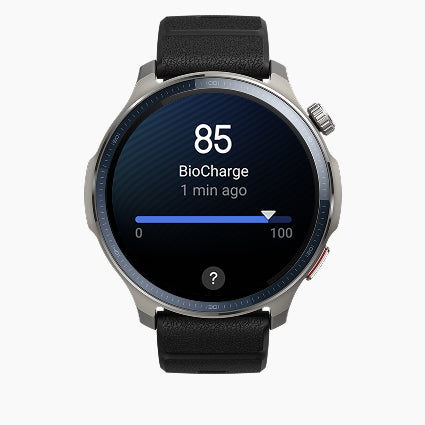
BioCharge Energy Monitoring
BioCharge is a personalized body energy management feature that continuously analyzes your energy levels by integrating data from your nighttime sleep, daytime naps, exertion, and stress indicators.
Your BioCharge score ranges from 0 to 100, typically reaching its peak upon waking in the morning after a full night’s sleep. As you go through the day, activities like exercise, work, and emotional stress gradually deplete your BioCharge. However, short naps or moments of relaxation can help replenish it. For the most accurate insights, it's recommended to wear your device throughout the day.
BioCharge helps you better manage your exercise routine by showing when your body is primed for activity or needs recovery. A high score indicates that you have enough energy to take on a workout, while a low score suggests that rest might be more beneficial. -
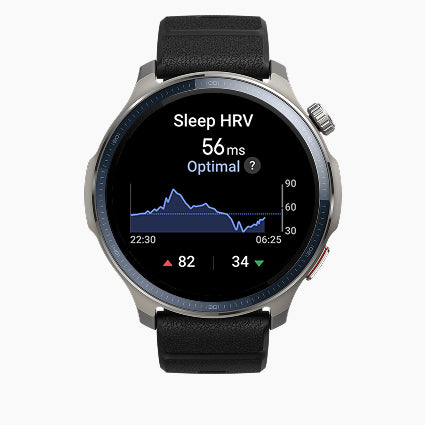
Heart Rate Variability (HRV)
HRV is calculated by measuring the variations in the time intervals between consecutive heartbeats. Amazfit devices measure HRV using the RMSSD method, which stands for the root mean square of successive differences between normal heartbeats. RMSSD primarily reflects how well the autonomic nervous system regulates the body, making it a key indicator of cardiac health, stress levels, and overall well-being.
Your HRV baseline is established using approximately seven days of continuous sleep HRV data. By comparing daily HRV values to this baseline, you can better assess your current health and recovery status.
HRV ranges can vary widely between individuals and are influenced by factors such as age, gender, and overall health. In general, a healthy adult’s HRV may range from 20 ms to 200 ms, with values typically decreasing with age.Higher HRV often indicates good cardiovascular and nervous system adaptability, lower stress levels, and strong recovery capacity.
Lower HRV may signal elevated stress, fatigue, or other health concerns.
Tips to Improve HRV:Engage in regular physical activity
Prioritize high-quality sleep
Practice mindfulness, deep breathing, or yoga
Maintain a balanced diet and limit caffeine and alcohol intake
Note: For the most accurate HRV readings, wear your device properly and remain still during measurement. If the HRV Sleep Timeline appears incomplete, it may indicate movement or improper device placement. This feature is currently available on select Amazfit devices. -

Heart Rate Zones
During every activity, your device automatically tracks your heart rate and classifies the intensity into five heart rate zones, helping you understand how hard you're training and which energy systems you're engaging. These zones are based on your Maximum Heart Rate (HR max), which the watch estimates using your age or a custom value you provide. Alternatively, zones can be calculated using the percentage heart rate reserve method, which factors in both your resting and maximum heart rates stored in your profile settings.
Heart Rate Zones:Zone 1: Light Effort (50–60% of HR max)
Intensity: Very light
Purpose: Warm-up, cooldown, active recovery
Feels like: Easy pace, light breathingZone 2: Fat Burn (60–70% of HR max)
Intensity: Light
Purpose: Improves basic endurance, promotes fat metabolism
Feels like: Sustainable pace, comfortable conversationZone 3: Aerobic (70–80% of HR max)
Intensity: Moderate
Purpose: Builds cardiovascular fitness and endurance
Feels like: Steady effort, deeper breathing, talking becomes difficultZone 4: Anaerobic (80–90% of HR max)
Intensity: Hard
Purpose: Improves speed, power, and VO₂ max
Feels like: High effort, heavy breathing, limited speechZone 5: Maximum Effort (90–100% of HR max)
Intensity: Maximum
Purpose: Peak performance, sprinting, high intensity intervals
Feels like: Short bursts, all-out effort, cannot be sustained for long -
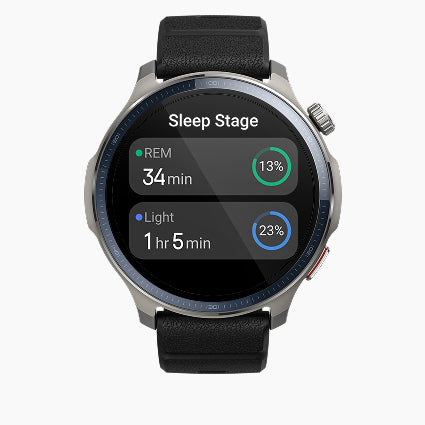
REM Sleep Tracking
Rapid Eye Movement (REM) sleep is a vital stage of the sleep cycle and is typically when dreaming occurs. During REM, brain wave activity increases, heart rate elevates, breathing becomes irregular, and the eyes move rapidly and unpredictably.
REM sleep usually accounts for 10% to 35% of total sleep time.REM sleep plays a key role in both memory consolidation and emotional regulation:Memory consolidation: REM integrates experiences, knowledge, and interactions from the day with existing memories, helping to form new long-term memories.
Emotional regulation: The amygdala—responsible for processing emotions—is active during REM, helping you manage and release negative emotions.
How to maintain healthy REM sleep levels:Avoid sleep-disrupting medication: Some sleep aids may interfere with REM sleep. Always consult your doctor before using them.
Keep a consistent sleep schedule: Going to bed and waking up at the same time each day helps regulate your sleep cycle and promote REM.
Optimize your sleep environment: Minimize noise, block out light, and maintain a comfortable room temperature and humidity level.
Exercise regularly: Consistent, moderate exercise supports better overall sleep quality, including REM sleep.
-
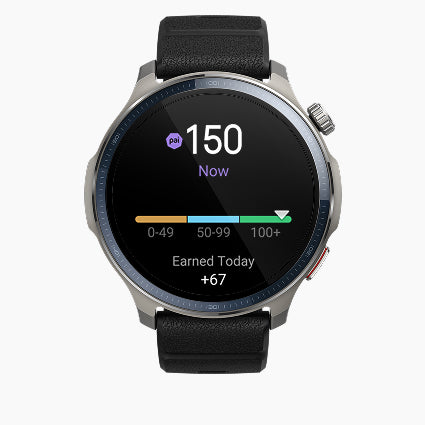
PAI
PAI is a personal physiological activity indicator based on heart rate data, combined with daily activity intensity and a multi-dimensional evaluation of your physical condition. This data is processed through a scientific algorithm and converted into a simple, easy-to-understand PAI score. It does not rely on a single data point but provides a more complete picture of your health.
You only need to maintain a certain level of daily activity or exercise to generate a PAI score. According to findings from the HUNT Fitness Study, keeping your PAI above 100 may help reduce the risk of cardiovascular disease and increase life expectancy.
**HUNT Fitness Study: A sub-project of the HUNT Study, led by Professor Ulrik Wisloff at the Norwegian University of Science and Technology. The HUNT Study has been ongoing for over 35 years and includes data from more than 230,000 participants. -
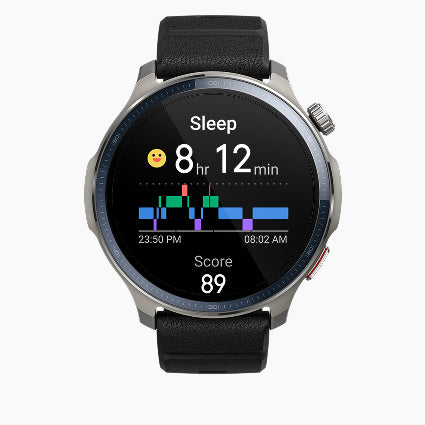
Sleep Tracking
Amazfit devices, integrated with the Zepp app, offer comprehensive sleep tracking features designed to help you understand and improve your sleep quality. Here's an overview of what you can expect:
Key Sleep Tracking FeaturesAutomatic Sleep Detection: Amazfit devices automatically monitor your sleep patterns, including nighttime sleep and daytime naps, without requiring manual input.
Sleep Stage Analysis: The devices track various sleep stages—light, deep, and REM sleep—using a combination of heart rate monitoring and motion sensors. This analysis helps you understand the quality and structure of your sleep.
Sleep Score: Each night, you receive a sleep score that summarizes your sleep quality, taking into account duration, consistency, and restfulness.
Breathing Quality Monitoring: Some models offer sleep breathing quality monitoring, providing insights into your respiratory patterns during sleep.
Assisted Sleep Monitoring: This feature enhances the accuracy of sleep tracking, particularly in detecting REM sleep stages, by incorporating additional heart rate data.
Sleep Reports: Detailed sleep reports are available in the Zepp app, offering insights into your sleep trends over time and suggestions for improvement.
How It Works
Amazfit devices utilize a combination of sensors to detect sleep onset and stages. The data collected is synced with the Zepp app, where it's analyzed to provide comprehensive sleep insights. By leveraging these features, Amazfit aims to empower users to make informed decisions about their sleep habits, contributing to overall well-being and daily performance. -
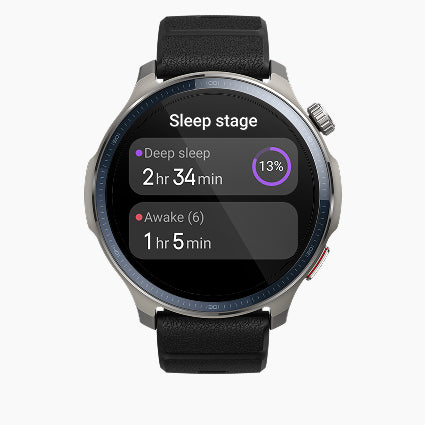
Deep Sleep Tracking
Deep sleep is a critical part of the sleep cycle. It typically accounts for more sleep time in children and adolescents, stabilizing in adulthood at around 10% to 35%, and gradually decreasing with age. As a form of restorative sleep, deep sleep plays a vital role in relieving daily fatigue and helping the body recover strength—leaving you feeling more energized the next day.
What are the effects of insufficient deep sleep?
According to the European Journal of Physiology and Sleep Medicine, not getting enough deep sleep can lead to:Cell aging: Insufficient deep sleep impairs the body's natural repair mechanisms, which can accelerate the aging process.
Weakened immunity: Even short-term lack of deep sleep can reduce immune function, causing symptoms like nausea, dizziness, fatigue, and brain fog—early signs of illness and lower resistance.
Nervous system disruption: The nervous system regulates organ function and hormone secretion. Deep sleep is essential for keeping these systems in balance.
Endocrine imbalances: Poor deep sleep may trigger hormonal disruptions, increase the risk of insulin resistance and cardiovascular issues, and contribute to high blood sugar.
How can I improve deep sleep?Avoid caffeine, alcohol, and heavy meals before bed.
Take a warm bath or soak your feet 1–2 hours before bedtime.
Avoid intense exercise within 3 hours of sleep.
Listen to calming music or sleep melodies.
Stick to a regular sleep schedule to support your body’s natural rhythms.
Create a comfortable environment: keep the bedroom dark, quiet, and set to an ideal temperature.
Incorporate regular, moderate exercise into your daily routine.
-
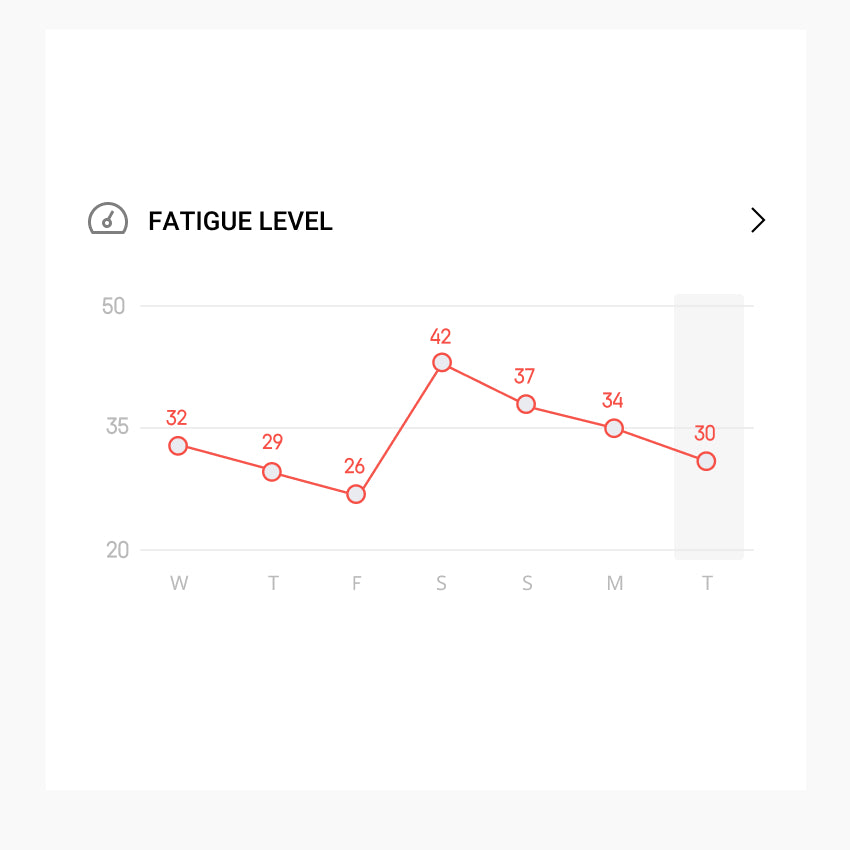
Fatigue Level
Fatigue Level, also known as Acute Training Load (ATL), reflects your recent exertion levels. It's calculated using a weighted average of your exertion from activities over the past 7 days. As this value rises, you're more likely to experience fatigue from training.
-
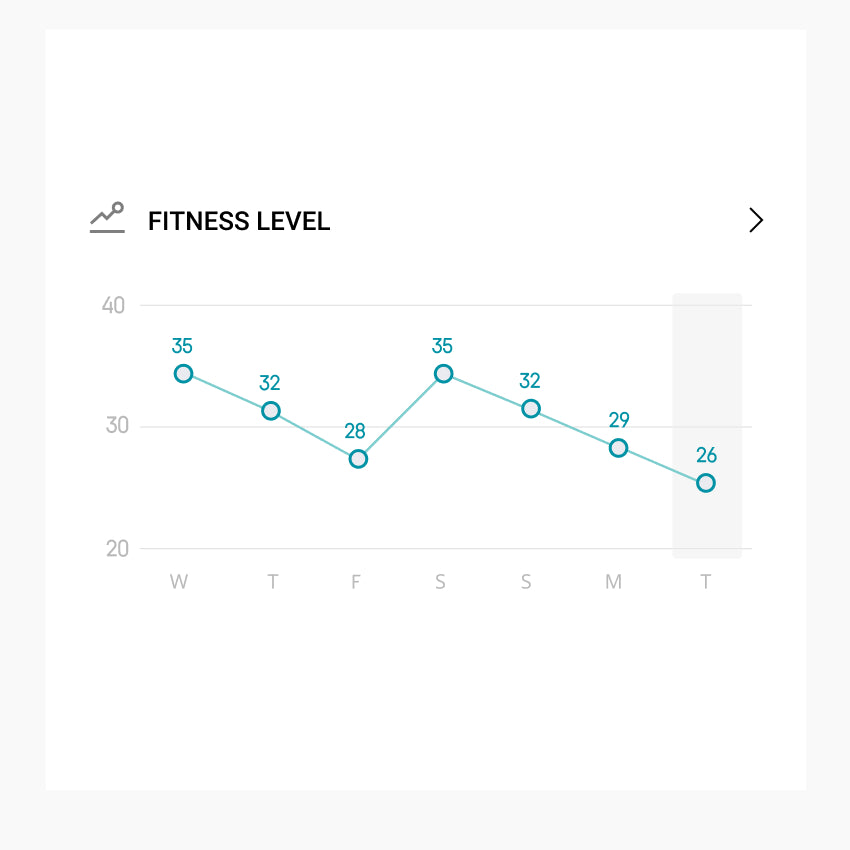
Fitness Level
Fitness Level, also known as Chronic Training Load (CTL), represents your long-term physical exertion. It’s calculated using a weighted average of your activity exertion over the past 42 days. Simply put, as this value increases, your body adapts to handle greater training loads, leading to improved physical performance.
-
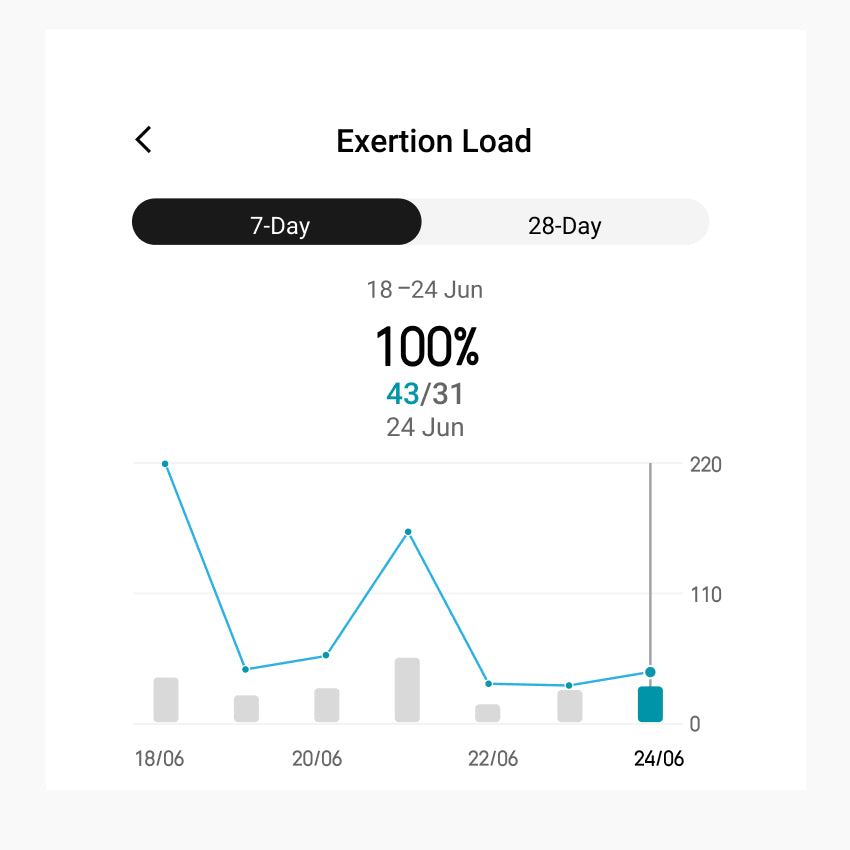
Exertion Load
Daily Exertion Load is a metric that measures your total energy expenditure throughout the day. It accumulates not only during dedicated workouts but also during any daily activity that causes an elevated heart rate. This metric is estimated using our exclusive algorithm, which is based on Training Impulse (TRIMP) and training load principles.
Note:
Daily Exertion Load is only calculated when your heart rate stays above a minimum threshold for at least 3 minutes. This threshold is personalized based on your resting and maximum heart rate and typically falls around 55–60% of your maximum heart rate.To ensure accurate tracking, workout data must be synced on the same day as the activity. Historical workout records that are synced or imported later will not be included in that day’s exertion load calculation.
Daily Exertion Target:
Your daily exertion target is based on a combination of your Readiness score, current training status, and training plan type. If your Readiness score drops and your body is no longer suited for high-intensity activity, the target may be automatically adjusted to match your physical condition and training goals.














